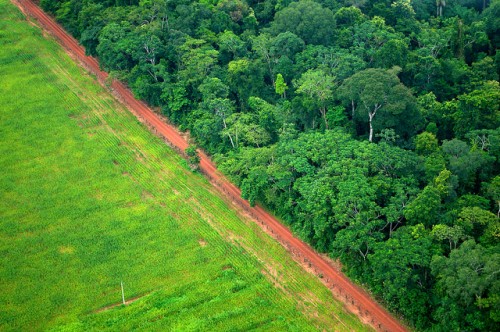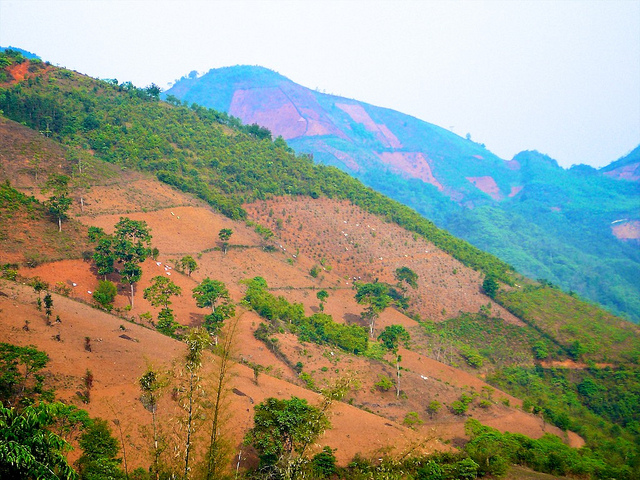
This interview is Part 1 of a three-part series on forest landscape restoration to coincide with the IUCN World Conservation Congress, held from 1-10 September in Hawai’i, USA.
The Center for International Forestry Research (CIFOR) will be represented in various panels and sessions at the event as part of the KNOWFOR partnership with the World Bank Program on Forests (PROFOR) and the International Union for Conservation of Nature (IUCN), funded by the UK Department for International Development (DFID).
Louis Putzel, CIFOR Senior Scientist, spoke with Forests News ahead of the event:
What is forest landscape restoration?
I would say forest landscape restoration is a large-scale planning process that involves improving the ecological functions of landscapes by replacing or increasing the amount of tree cover. It’s a very flexible concept and includes practices ranging from setting land aside for natural regeneration to plantation forestry.
The basic principle is that increasing biomass in landscapes – and that can be trees, shrubs or even grasses, like bamboo – generates multiple environmental benefits such as carbon capture, water purification and flood control.
What aspects of FLR are your team interested in researching?
The KNOWFOR project team I work with is mostly looking at government FLR programs in hilly and mountainous landscapes populated by farming communities. There’s a lot of work to do on the human dimensions of FLR, because a lot of the land identified as important to restore for environmental reasons is currently occupied by people. Some of it is very densely populated and has been used for agriculture or grazing for hundreds if not thousands of years. So restoration in such spaces involves trade-offs with food production, at least at the local level and in the short term. In areas that are economically challenged anyway, that’s a major consideration.
Under the Bonn Challenge [a global effort to restore 150 million hectares of degraded land by 2020 and 350 million hectares by 2030] – Ethiopia has committed 15 million hectares, the Democratic Republic of Congo has committed 8 million hectares, Rwanda has committed 2 million hectares.
So in such places there are major issues to work out: who owns the land, who has rights to the land, what is the land being used for, what are the economic benefits of agriculture, what are the food needs of the people? All those things need to be compensated for if that land is to be converted to forest.
These questions are now looming, and there’s a need for a huge amount of research. Because as with REDD+, a lot of the restoration is going to be happening where people are already living on the margins.
This is for a number of reasons. A lot of the areas that are degraded are likely to be poorer areas in the first place. Another reason is that it’s cheaper to compensate poorer people. So the lands identified for restoration are likely to be those where opportunity costs are low – so by definition, where people are poor.
We can learn a lot by studying the experience of countries with a long track record in landscape-level restoration. So in addition to reviewing literature, visiting smallholder restoration areas and analyzing data, we at CIFOR are doing a lot of knowledge exchange with our partners, bringing together people from international organizations like IUCN, INBAR, and others to exchange with government forestry people all over, from China and Africa to the US.
You’ve been spending lots of time in China and have been analyzing forest landscape restoration practices there. What lessons can be drawn from China’s experience?
For several years we’ve been working with the Forest Economics and Development Research Center, a think-tank attached to China’s State Forestry Administration.
FLR as a field has a lot to learn from China. Because China is so big and diverse, and has suffered such serious consequences from deforestation in the past, they’ve had to implement a huge range of strategies to get trees back into the landscape, from conservation and protection or ‘exclosure’ of ecologically fragile slopes, to actual conversion of agricultural land to forest. One such program, the Conversion of Cropland to Forest Program, pays farmers to plant trees in their fields, and allocates degraded lands to families to restore.
Just under that one program, they’ve so far converted nearly 30 million hectares of farmland and land classified as barren or degraded.
There are some important lessons about subsidies. The government has been subsidizing restoration on this large scale since 1999, and the idea has always been to reduce the subsidies, and eventually wean the people off them. But it’s important to consider how the landscape serves people’s economic needs in the long run, once the subsidies have ended. How will cycles of dependency affect sustainability?
China’s case is complex because the restoration is happening at the same time as mass migration from rural to urban areas and major changes in employment structures, as well as comprehensive tenure reform, which all have effects on land use, tending to reduce pressure in rural areas and increase it around cities.
From our systematic review of the Conversion of Cropland to Forest Program (CCFP) it’s pretty clear that CCFP subsidies give a bit of a push to people to do less farming and to plant trees before leaving their land to go take work in towns nearby or in other provinces.
Another lesson from China is that FLR doesn’t always work as expected. From an ecological perspective, restoration of degraded areas is a science that requires very specific knowledge of local ecology, good matching of species and practices to sites. There have been areas where the species chosen for planting required more water than was available, reducing survival and requiring replanting.
The CCFP has increased China’s forest area by something like 3 percent in just 15 years, which is very impressive. Some of the new forest cover isn’t very diverse, but of course, forests change over time, so more species could potentially migrate into areas that have more trees.
But these are things to consider in FLR around the world. As governments look to restoring forest in mosaic agricultural lands, for example, are they going to increase or decrease biodiversity, or economic benefits, or water ecosystem services? How does the restored forest compare to mosaic agricultural lands that are already diverse in structure and function?
In a rush to restore forest area, we sometimes see an expansion of fast-growing tree monocultures – plantations of eucalyptus, pine, poplar or rubber. These may restore economic benefits, and if the land was severely degraded before, may increase environmental services somewhat, and they certainly can store carbon if managed for that.
FLR is not just what the landscape looks like today, it’s about imagining what it will look like in the future, long after the restoration activities have occurred.
Finally, restoration depends on tremendous financial resources. We are talking about billions of dollars, not millions, to restore landscapes on the scale of the Bonn Challenge. Big countries like China, and the United States as well, can give us a sense of the magnitude of funding needed to compensate millions of farmers for increasing landscape ecosystem services through restoration.
What is your message to those meeting at the IUCN World Congress about FLR?
FLR is not just what the landscape looks like today, it’s about imagining what it will look like in the future, long after the restoration activities have occurred. It’s about understanding ecological processes over the long term at the landscape level. This is something that’s challenging for a big and diverse group of government and conservation organizations to do, because ecological and social conditions vary tremendously from place to place.
FLR requires tremendous capacity for planning, for delineating space, for communicating with the populations living in the restoration areas, for creating the systems whereby they will adopt restoration programs. Personally, I think national governments still have to play a key role in balancing between uses, taking responsibility for trade-offs, and deploying funds on the scale required. And also in being there for the long term – international development project cycles are too short, and private investment requires a return before too long.
The Bonn Challenge is definitely doable, but it is a major endeavor that requires a lot of research and smart policy. And the social angle requires a huge amount of attention – to a large degree that has been overlooked or given short shrift so far.
In the end, we need to ask who will inherit or benefit from restored landscapes, and how can we ensure people living in the most remote target areas end up better off than before? If more trees and forests benefit them enough to make FLR work, we all win.
We want you to share Forests News content, which is licensed under Creative Commons Attribution-NonCommercial-ShareAlike 4.0 International (CC BY-NC-SA 4.0). This means you are free to redistribute our material for non-commercial purposes. All we ask is that you give Forests News appropriate credit and link to the original Forests News content, indicate if changes were made, and distribute your contributions under the same Creative Commons license. You must notify Forests News if you repost, reprint or reuse our materials by contacting forestsnews@cifor-icraf.org.



